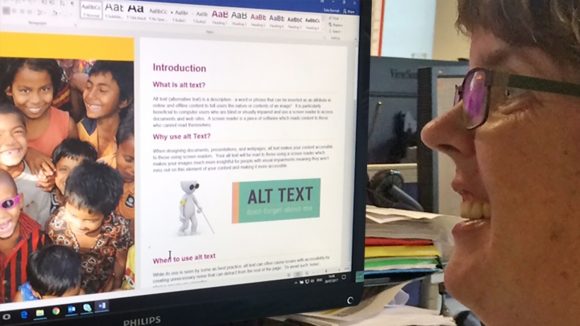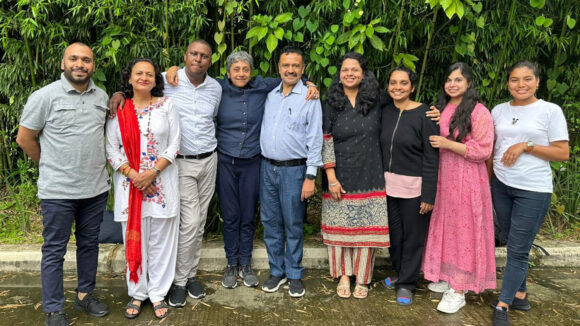Accessibility of remote meeting tools
In the age of home working, Sightsavers’ Kate Bennell looks at the various meeting tools and their suitability for users with visual impairments and other disabilities. In part two of this blog, she looks at online tools used during remote meetings.
Read part one, where she looks at remote meeting platforms, here.
Miro Boards
Miro is a collaborative online whiteboard platform designed for remote teams. My colleagues trialled it for some of our disability awareness training activities before finding alternative solutions through Microsoft Teams, which seem to function equally well.
Accessibility features
Miro offers switch access, which provides an alternative to the touchscreen enabling the user to use a switch, a keyboard or a mouse to navigate around the board.
Challenges and improvements needed
From the perspective of a visually impaired user with some residual sight, Miro boards is not great. Early on in the lockdown I had a bad experience when, as we split out into different rooms, and I found myself left out of discussions with the team I was in, with no idea how to get into the room I was supposed to be in. I learned in a later session that it is possible to piggy-back onto another user and therefore be led by them around the interactive board, which made it much easier to follow.
With limited sight it would be very challenging to solely facilitate sessions on a Miro Board particularly when trying to perform specific tasks (including reading back sticky notes posted by a team in a specific area of the board). It is possible to create new sticky notes within an area of the board and to type into them using keyboard commands and so to participate in the session. Visual information within the boards is not screen reader friendly and there are no high contrast options available for those with colour blindness or other visual impairments. It will be great when the sticky notes can recognise and convert writing to typed text and then become screen reader friendly.
Slido
Slido is an easy to use Q&A and polling platform. It helps people to get the most out of meetings and events by bridging the gap between speakers and their audiences during events, enabling participants to ask questions and take part in audience votes and polls.
Slido works well with a screen reader with all functions being accessible including when creating and participating in polls. In addition, you can use the screen reader to navigate questions and participate in polls using keyboard shortcuts.
As well as participating in polls, Slido is accessible with the results, enabling you to upload them directly to a PowerPoint presentation from which means they can be read by a screen reader which will also highlight the most popular results.
Mentimeter
Mentimeter is an easy-to-use presentation software which enables the user to create fun and interactive presentations.
As a tool, it helps by gathering live visual feedback from audiences and enables meeting participants to contribute in a way that they wouldn’t be able to do face-to-face.
Mentimeter is very much a visual tool and although you can participate in the surveys using a screen reader, the screen reader does not announce the results as they update in your presentation. The screen reader just picks up on the images rather than the details contained within the images unless the presenter has provided alternative text. It is therefore advisable to consider the content of your polls and to carefully explain the results within your discussions. By doing this you can adapt the accessibility of the feedback.
Conclusion
“Effective remote working requires a solid digital infrastructure – as well as an inclusive culture, which is responsive to the needs of all employees, especially those with disabilities and chronic conditions.“
In preparing this blog, as well as drawing on my own experiences, I have also used those of a colleague who is deaf. One thing we very much agreed on is that ultimately, it has been an amazing, incredible experience, as a year or two ago, it wouldn’t have been possible to attend meetings and conferences online due to challenges with internet connectivity and speed, lack of live captioning and screen readability. Thanks to advances in technology and the platforms we have been able to use during the pandemic we have both been able to follow most meetings better than we do in person.
It’s interesting to reflect on how, when coronavirus broke out, remote working became a necessity for many people and therefore balanced the playing field somewhat between those with chronic illness or disability who often thrive with more flexible working conditions. But it’s also important to remember that effective remote working requires a solid digital infrastructure – as well as an inclusive culture, which is responsive to the needs of all employees, especially those with disabilities and chronic conditions.
It’s great now that accessible online meetings have become more widely available, but we need to ensure that things don’t go back to the ‘old normal’ after the pandemic, and that the needs of people with disabilities continue to be considered in meeting forums and other elements of work to enable those of us who experience disabilities to continue to thrive alongside those without. If you want to learn more about this, you can read my recent blog on Civil Society magazine on building back and inclusive workplace post lockdown.
I hope this blog will help you identify the most accessible meeting platforms and tools based on your needs and those of your organisation.
What is your experience of using these and other platforms and their accessibility features? I would love to hear your best and worst experiences and learn more about accessible online platforms and tools. You can contact me at [email protected].
Author
 Kate Bennell is the organisational inclusion coordinator at Sightsavers UK. Severely sight impaired herself, she coordinates the Social Inclusion Working Group and champions accessibility.
Kate Bennell is the organisational inclusion coordinator at Sightsavers UK. Severely sight impaired herself, she coordinates the Social Inclusion Working Group and champions accessibility.
LinkedIn
Read about Sightsavers’ commitment to inclusion
Social Inclusion Working GroupMore from the
Social Inclusion Working Group

How to support people with hydrocephalus at work
Sightsavers’ Kate Bennell shares her experience of living with hydrocephalus and explains how employers can support colleagues with the condition.

How people with psychosocial disabilities can claim their rights
Sightsavers’ Kate Bennell reflects on a recent talk led by Transforming Communities for Inclusion about psychosocial disabilities.

“My aim is to make the world a better place for disabled people”
Sightsavers’ Kate Bennell talks to Peter Fremlin, curator and author of the Disability Debrief, about the online newsletter which provides a disability lens on world news.


